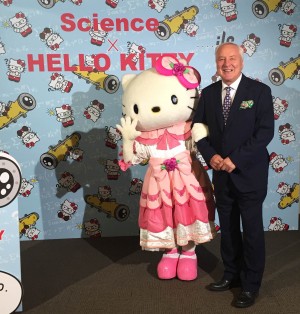
Engaging with the Japanese public means taking on board local heroes… Science × Hello Kitty (c) 1976, 2016 SANRIO CO., LTD.APPROVAL NO.S571891
The linear collider community will conclude the year at the LCWS in Morioka in December. I know that travel funding is tight for many of you but it is important to have a good turnout at this workshop to show the strong continuing international interest and commitment in the construction of a linear collider as an essential next step in our quest to understand nature at the deepest level.
We have been clearly told that there will be no decision from Japan concerning its wish to host the ILC for at least the next two years. Consequently, we have to adjust our objectives to cope with the meagre recourses that will be available during this time. The International Committee for Future Accelerators ICFA has decided that the Linear Collider Collaboration structure with the Linear Collider Board as oversight body should remain, but be slimmed down. The Machine Advisory Committee, which was useful for a technical review of the TDRs, will now be mothballed until a final decision is made and a real project structure is in place. The roles of Regional Directors will be, at least formally, abolished. It has been difficult if not impossible for our colleagues who are currently assuming these roles to make much progress in promoting the ILC due to the lack of interaction between the executive in Japan and other governments. Physicists can explain to their governments the scientific interest and strong will to collaborate but they cannot do much more until formal contact has been made between administrators. Once political agreements are reached we have shown that we can be very effective in collaborating to build a project of the size of the ILC, as testified by the LHC.
Bilateral discussions have now opened between the Japanese and US administrations. So far, these discussions have had both good and bad effects on our community. It has been agreed that the next two years should be used for R&D leading to cost reduction, albeit with totally inadequate resources. However, this comes at a price that design work, especially in the US, will be stopped to liberate these resources. As Mike Harrison explained in a previous article, it is now important to carefully document the work that has already been done so that if the green light is given, the final design can start from a sound basis. The next step will now be to open up a similar dialogue with governments in Europe and Asia. This will be particularly challenging in Europe due to the large number of countries involved, although CERN has been mandated to be the entry point for its Member States. Once this dialogue starts in earnest, we must rely on all of you to educate your administrations.
Fortunately, there is a strong interest in Superconducting Radio Frequency (SCRF) and its associated technologies around the world independently of the ILC. We must now see how we can profit from these worldwide R&D activities to push forward the ILC design with very limited resources. For this reason, there will be a workshop during LCWS where the plans over the next two to three years, not only for SCRF R&D but also for associated technologies, of the concerned laboratories will be discussed in order to get a global picture of what can be achieved.
In the meantime, we will continue to provide the Japanese government and its associated committees with all the information they request. We will also engage more with the general public, especially in Japan, to explain the scientific case and more broadly the advantages of having a flagship International Organization in Japan.
I hope to see you in Morioka.


Recent Comments